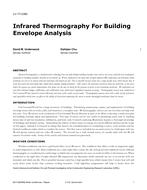Description
Infrared thermography is a nondestructive technology that can help identify building envelope issues such as wet areas and lack of or inadequate insulation in building envelopes invisible to the human eye. When conducted at the right time of night infrared (IR) inspections can determine which materials are wet or in contact with wet materials and which are dry. This is possible because water has a high specific heat, which means that it stores heat well and cools down more slowly than common roofing materials. After sunset, dry materials cool faster than wet materials, so the areas where the camera sees warm temperatures (hot spots) are the ones to check for the presence of water or wet insulation materials. IR inspections can also detect thermal bridges, infiltration, and exfiltration issues which waste significant amounts of energy. Thermography surveys were conducted at Fort Leonard Wood, located in central Missouri and some of the results are presented. Thermography cameras come with a wide variety of features and capabilities which have an effect on the ability of the person conducting the survey to make meaningful conclusions from the survey.
Citation: 2017 Winter Conference, Las Vegas, NV, Conference Papers
Product Details
- Published:
- 2017
- Number of Pages:
- 8
- Units of Measure:
- Dual
- File Size:
- 1 file , 2 MB
- Product Code(s):
- D-LV-17-C065




